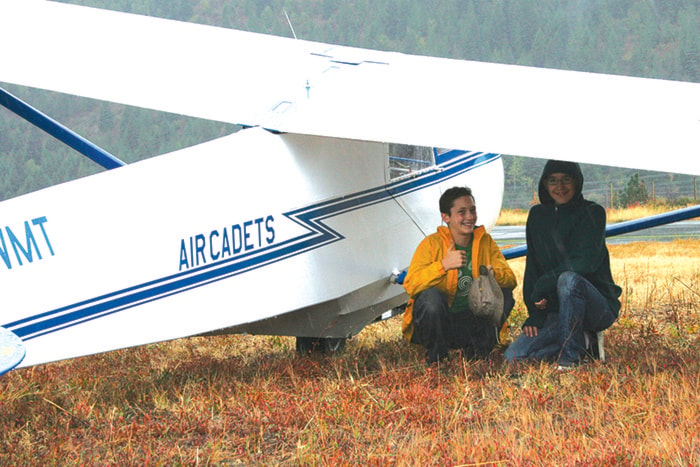On a recent cold and rainy Saturday, a group of Castlegar's air cadets from the 581 Squadron gathered at the Trail Regional Airport for glider familiarization flying exercises. As the group huddled in the parking lot, waiting for everyone to arrive and for clearance to enter the runway area, they began to discuss the day. All but one of the cadets present had participated in gliding exercises before and the newbie acknowledged she was a bit scared about going up, especially without any engines. Several others were worried about motion sickness. The group also reminisced about previous flights and several of them agreed that they liked riding in the tow plane better than the glider.
When the cadets were given permission to enter the airport, they gathered near the runway and ranking cadet WO2 Jordan Gardner organized the group into two teams that would alternate doing the ground work required to get the gliders off the ground and then back off the runway once they had landed. Although the crew was getting wetter by the minute, Sgt. Colley, FCpl. Koponyas, FCpl. Johnson, FCpl. Silva, Cpl. Johnson, Cpl. McLachlan, Cpl. Stetsko-Kallin, LAC Longardand and AC Colley were still looking forward to some time in the sky.
As a tow plane launching a glider with cadets from Trail's 531 Squadron hummed in the background, Cpt. Matthew Craig introduced the cadets to a Schweizer 2-33 glider. The two-seat aircraft beacame the center of attention for the next bit as Craig emphasized the need to pay attention, avoid horseplay, keep earphones out and put away electronic distractions. This was followed by a series of instructions and anecdotal stories about cadets who didn't heed the advice and ended up with various injuries due to their lack of attention to instructions. When asked later if the instructions made them nervous, one of the cadets laughed and said, "If we die, we die — we die doing something we love," no nervousness in her voice whatsoever.
The instructions started with how to get in the plane, and how to buckle in. "It's like getting on a horse," said Craig. "You put your right foot on the stirrup and you swing your leg over and put it on the floor board."
The next set of instructions were focussed on how to push the glider into position — carefully, not too fast, and nice and easy over the bumps. Cadets were told how to hold the plane and where and where not to put pressure. "To tell you the truth," added Craig, "the most dangerous place out here today is on the ground. Up in the air you're safe, there's nothing to hit."
As the rain got even heavier than before and the clouds began to look more ominous, the cadets learned the hand signals that would be necessary to direct the tow plane and glider off the ground. Looking a bit like a dance class, the cadets moved through the various positions with ease.
Unfortunately after a thirty minute delay, while the pilots waited for the clouds to lift a bit, the cadets learned another lesson that is essential for flying — when the weather is bad, the plane stays on the ground. The cadets will get another chance to fly in the spring — as long as the weather cooperates.
